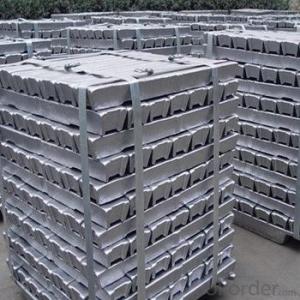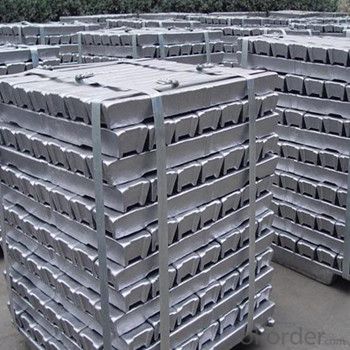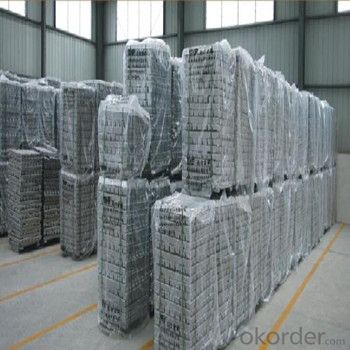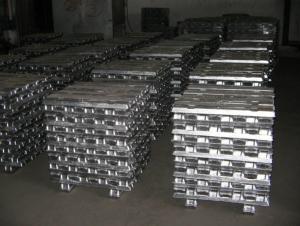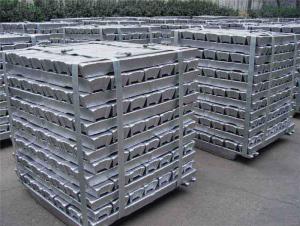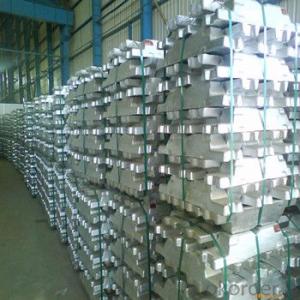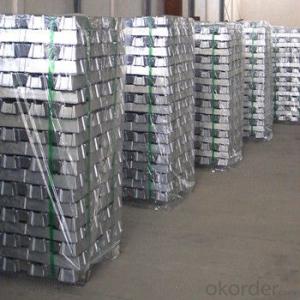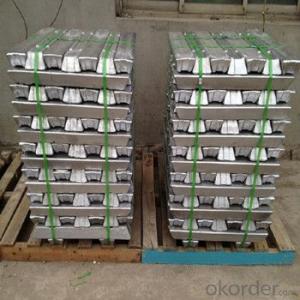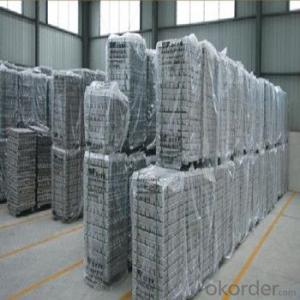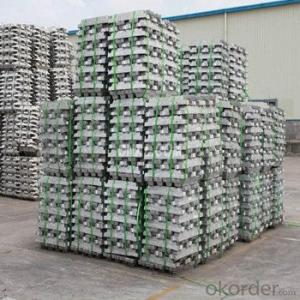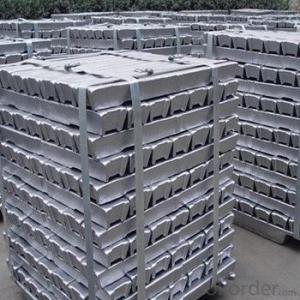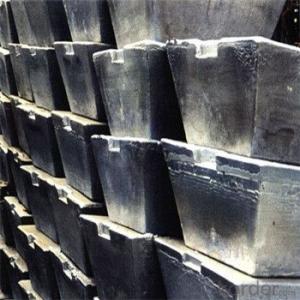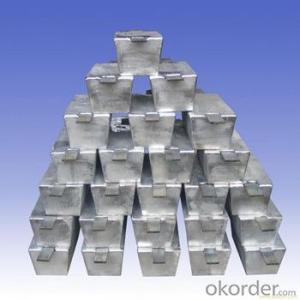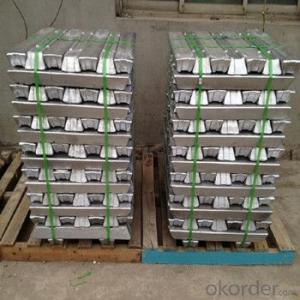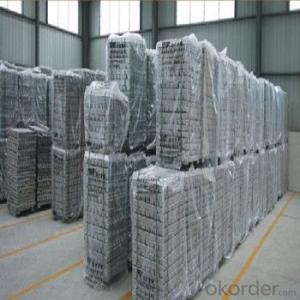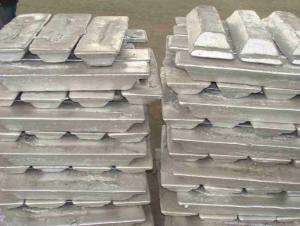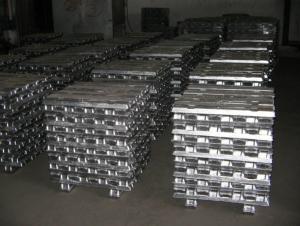Aluminum Pig/Ingot With Grades And Purity For Choice
- Loading Port:
- China main port
- Payment Terms:
- TT OR LC
- Min Order Qty:
- 1000 m.t.
- Supply Capability:
- 100000 m.t./month
OKorder Service Pledge
OKorder Financial Service
You Might Also Like
Pure Aluminum Pig/Ingot Used for Industry
1.Structure of Aluminum Pig/Ingot
A material that has been cast into a shape in order to be transported and processed easier than in an unprocessed form. An ingot is typically rectangular in shape, which allows it to be stacked. Ingots are most commonly associated with metals, with ingots of gold held in the vaults of banks and brokerages being popular images.
Aluminum Ingot is with the AL as the main chemical composition.Aluminum Ingot is used for industry,such as automobile,pinning and weaving,electron broadly and so on. Aluminum Ingot has the following advantages: easy control and operation, fast melting.
2.Main Features of the Aluminum Pig/Ingot
•High Purity
•Easy control and operation
•High strength
•Fast melting
•Competitive price
•Best Service
3.Aluminum Pig/Ingot Images
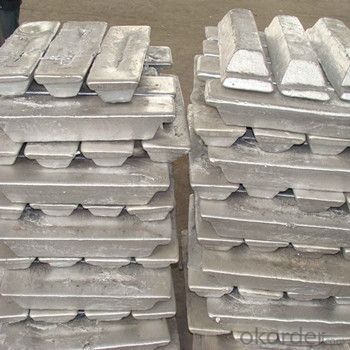
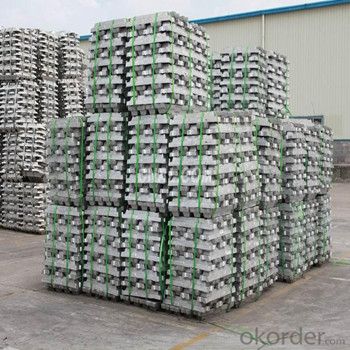
4.Aluminum Pig/Ingot Specification
Grade | Chemical Composition % | |||||||||
Al≥ | impurities ≤ | |||||||||
Si | Fe | Cu | Ga | Mg | Zn | Mn | others | Sum | ||
Al99.9 | 99.90 | 0.50 | 0.07 | 0.005 | 0.02 | 0.01 | 0.025 | - | 0.010 | 0.10 |
Al99.85 | 99.85 | 0.80 | 0.12 | 0.005 | 0.03 | 0.02 | 0.030 | - | 0.015 | 0.15 |
Al99.7 | 99.70 | 0.10 | 0.20 | 0.010 | 0.03 | 0.02 | 0.030 | - | 0.030 | 0.30 |
Al99.6 | 99.60 | 0.16 | 0.25 | 0.010 | 0.03 | 0.03 | 0.030 | - | 0.030 | 0.40 |
Al99.5 | 99.50 | 0.22 | 0.30 | 0.020 | 0.03 | 0.05 | 0.050 | - | 0.030 | 0.50 |
Al99.00 | 99.00 | 0.42 | 0.50 | 0.020 | 0.03 | 0.05 | 0.050 | - | 0.050 | 1.00 |
5.FAQ of Aluminum Pig/Ingot
We have organized several common questions for our clients,may help you sincerely:
①How about your company?
A professional factory which foucs on producing the aluminum pig,can meet customers' requiement to the quality and grade.The quality also have been accepted by customer.Already got the good reputation among the customers.It have gotten lot of much experience.The facrtory has the professional Technical Worker and the advanced equipments for production.Beside,it has the profesional teams to operate the whole proess for exporting.OEM service is availble and welcome.The items have beedn exported around the world,and have been acceptable among the customers,and have gotten the good reputation already.No matter from the quality,price and service,can be guaranteed for the cusgtomers.High purity and diffent grade are available.
②How to guarantee the quality of the products?
We have established the international advanced quality management system,every link from raw material to final product we have strict quality test;We resolutely put an end to unqualified products flowing into the market. At the same time, we will provide necessary follow-up service assurance.
③How long can we receive the prod rking days, We will arrange the factory delivery as soon as possible. The pecific time of receiving is related to the state and position of customers.Commonly 7 to 10 working days can be served.
- Q: How is an aluminum ingot made?
- An aluminum ingot is made through a process called smelting. The first step in the production of an aluminum ingot is the extraction of alumina from bauxite ore. Bauxite is first mined and refined to obtain alumina, which is a white powder-like substance. The alumina is then mixed with cryolite, a mineral that lowers the melting point of alumina, and placed in large pots called electrolytic cells. These cells are lined with carbon cathodes and act as the containers for the smelting process. Electricity is passed through the cells, causing a chemical reaction that separates the oxygen from the alumina. The oxygen combines with the carbon from the cathodes, creating carbon dioxide, while the aluminum ions are reduced to aluminum metal. The molten aluminum collects at the bottom of the cells and is periodically drained out. Once the molten aluminum is drained, it is usually transported to a casting facility. Here, the liquid metal is poured into molds to shape it into ingots. These molds can have various shapes and sizes, depending on the desired final product. The aluminum is then allowed to cool and solidify, forming the ingots. After solidification, the ingots are typically inspected for quality and purity. They may undergo further processing, such as heat treatment or surface finishing, depending on their intended use. Overall, the production of an aluminum ingot involves the extraction of alumina from bauxite, smelting alumina to obtain aluminum metal, and casting the molten metal into ingots. This process ensures the creation of high-quality aluminum ingots that can be used in various industries, including automotive, construction, and aerospace.
- Q: How are impurities removed from aluminum ingots during production?
- Impurities are eliminated from aluminum ingots in the production process through a refining process. The refining process typically consists of two primary steps: degassing and filtration. During degassing, the aluminum melt undergoes high temperatures and low pressures. This assists in the removal of volatile impurities, such as hydrogen, which can lead to porosity and brittleness in the end product. The high temperature and low pressure conditions permit the impurities to escape as gas bubbles, which are subsequently extracted from the melt. Filtration follows as the subsequent stage of impurity removal. The aluminum melt is passed through a filtration system containing ceramic filters or other porous materials. These filters are designed to trap solid impurities like oxides, non-metallic particles, and other foreign materials. The filters possess a specific pore size that exclusively allows the molten aluminum to pass through while retaining the impurities. This filtration process aids in enhancing the quality of the aluminum by reducing the levels of non-metallic inclusions, which can detrimentally impact the mechanical properties of the final product. It also contributes to regulating the grain structure and enhancing the overall homogeneity of the aluminum ingots. In conjunction with degassing and filtration, other refining techniques, such as fluxing and electromagnetic stirring, may also be implemented based on the specific requirements of the production process. Fluxing encompasses the addition of chemical compounds to the aluminum melt to facilitate impurity removal. Electromagnetic stirring employs electromagnetic fields to augment the mixing and distribution of the melt, thereby assisting in impurity elimination. Overall, impurities in aluminum ingots are effectively eliminated during production by combining degassing, filtration, fluxing, and electromagnetic stirring processes. These refining techniques guarantee that the final aluminum product adheres to the desired quality standards and exhibits optimal mechanical properties.
- Q: How much is a ton of aluminium ingots?
- Aluminum ingot one ton: 10 thousand and 2 - 10 thousand and 3 or so.
- Q: How many tons of alumina for a ton of aluminum ingot, alumina and electrolytic aluminum what is the difference?
- 1.889 tons of alumina contains a ton of metal aluminum. Or 1.889 tons of alumina can theoretically extract 1 tons of pure aluminum.
- Q: How are aluminum ingots used in the production of building facades?
- Aluminum ingots play a crucial role in the production of building facades due to their beneficial properties and versatility. The use of aluminum ingots allows for the creation of lightweight, durable, and aesthetically pleasing facades in modern architecture. Firstly, aluminum ingots are melted down and cast into various shapes and sizes, depending on the specific design requirements of the building facade. This casting process ensures that the aluminum is in a form that can be easily manipulated and fabricated into different components of the facade. Once the ingots have been cast, they can be extruded or rolled into sheets, panels, or profiles. These aluminum sheets or panels are then cut, shaped, and assembled to create the desired facade design. The ability to easily cut and shape aluminum allows for intricate designs and customization options, enabling architects to bring their creative visions to life. One of the key advantages of aluminum ingots in building facades is their lightweight nature. Aluminum has a low density, making it much lighter than other metals such as steel. This characteristic reduces the overall weight of the facade, making it easier to install and reducing the load on the building's structure. Additionally, the lightweight nature of aluminum enables larger and more expansive facade designs, allowing for greater design possibilities. Aluminum ingots also possess excellent corrosion resistance, which is essential for building facades exposed to various weather conditions. The natural oxide layer that forms on the surface of aluminum protects it from rust and corrosion, ensuring the longevity and durability of the facade. This resistance to corrosion reduces maintenance costs and extends the lifespan of the building facade. Furthermore, aluminum ingots offer a high degree of thermal conductivity. This property allows for effective thermal management in building facades, helping to regulate temperature and reduce energy consumption. Aluminum facades can be designed with insulation materials to enhance energy efficiency, contributing to sustainable building practices. In terms of aesthetics, aluminum ingots provide a wide range of finishing options. They can be anodized, painted, or coated in various colors and textures to achieve the desired appearance. Aluminum facades can also be combined with other materials, such as glass or stone, to create visually striking and modern facades that enhance the overall architectural design. In summary, aluminum ingots are extensively used in the production of building facades due to their lightweight nature, corrosion resistance, thermal conductivity, and design versatility. These properties allow architects and designers to create durable, energy-efficient, and visually appealing facades that contribute to modern architectural trends.
- Q: What are the properties of aluminum ingots?
- Aluminum ingots possess several distinct properties that make them highly valuable in various industries. First and foremost, aluminum ingots exhibit exceptional lightness, as they have a low density compared to other metals. This property makes them ideal for applications where weight reduction is crucial, such as in the aerospace and automotive sectors. Additionally, aluminum ingots possess excellent corrosion resistance, making them suitable for use in environments where exposure to moisture, chemicals, or harsh weather conditions is probable. This corrosion resistance is due to the formation of a thin, protective oxide layer on the surface of the ingot, which prevents further oxidation and deterioration. Another notable property of aluminum ingots is their high thermal conductivity, allowing them to efficiently transfer heat. This characteristic is particularly advantageous in heat exchange systems, where the ingots can facilitate the transfer of thermal energy. Moreover, aluminum ingots also exhibit excellent electrical conductivity, making them suitable for applications in the electrical and electronics industries. Furthermore, aluminum ingots have a high strength-to-weight ratio, making them strong yet lightweight. This property allows for the construction of structures that require both strength and durability without compromising on weight. Moreover, aluminum ingots are easily recyclable, retaining their properties even after multiple recycling processes, which makes them an environmentally friendly choice. Overall, the properties of aluminum ingots, including their lightness, corrosion resistance, thermal and electrical conductivity, high strength-to-weight ratio, and recyclability, contribute to their widespread use in various industries, ranging from transportation and construction to packaging and consumer goods.
- Q: Analysis of die casting aluminium ingot
- The commonly used classification, composition, die-casting aluminum ingot prices are as follows: the main element analysis table number grade classification (%) price (yuan / ton) Note: 9.6-12 1 ADC12 standard silicon, copper iron: 1.6,: 0.9,: 1,: 0.2 mg of zinc, lead as reference: 0.15
- Q: What are the advantages of using aluminum ingots in electrical applications?
- There are several advantages of using aluminum ingots in electrical applications. Firstly, aluminum is a lightweight metal, which makes it easier to handle and transport. Secondly, aluminum has excellent conductivity properties, allowing it to efficiently carry electrical current. Additionally, aluminum ingots are highly resistant to corrosion, making them durable and long-lasting in electrical applications. Lastly, aluminum is a cost-effective material compared to other metals, which makes it a more economical choice for electrical components.
- Q: How is the purity of an aluminum ingot determined?
- The purity of an aluminum ingot is typically determined through various analytical techniques. One of the most common methods involves using a spectrometer to measure the elemental composition of the ingot. This technique is known as optical emission spectroscopy (OES) or spark testing. In OES, a small sample from the aluminum ingot is vaporized using an electric spark, and the resulting emission of light is analyzed. Each element emits a unique spectrum of light, and by comparing the intensities of these spectral lines to known standards, the concentration of different elements in the ingot can be determined. This allows for the identification and quantification of impurities such as iron, copper, silicon, and other trace elements. Another method to assess purity is through chemical analysis. This involves dissolving a sample of the ingot in a suitable acid or solvent and performing various chemical reactions to quantify the impurities. For example, a common technique called atomic absorption spectroscopy (AAS) can be used to measure the concentration of specific elements in the solution. Besides these analytical techniques, other non-destructive tests like ultrasound or X-ray analysis can also be employed to assess the integrity and purity of the aluminum ingot. These methods can detect any internal flaws or inclusions that may affect the quality of the ingot. Overall, a combination of these analytical techniques is used to determine the purity of an aluminum ingot, ensuring that it meets the required specifications for various industrial applications.
- Q: What are the scouring agents in the die casting process, such as slag remover, coating agent, flux, and what matters should be paid attention to when the aluminium ingot is dissolved?,
- scouring agentFor refining alloy liquid, the main purpose is to remove the gas inside the liquid metal liquid, raise the density of the aluminum liquid die-casting
Send your message to us
Aluminum Pig/Ingot With Grades And Purity For Choice
- Loading Port:
- China main port
- Payment Terms:
- TT OR LC
- Min Order Qty:
- 1000 m.t.
- Supply Capability:
- 100000 m.t./month
OKorder Service Pledge
OKorder Financial Service
Similar products
Hot products
Hot Searches
Related keywords
